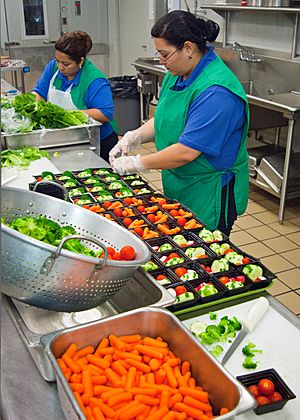National School Lunch Program facts for kids

The National School Lunch Program (NSLP) is a program run by the U.S. government. It helps provide healthy and affordable lunches to students in schools across America. For many kids, these meals are free or cost very little, making sure they get the food they need to learn and grow.
Contents
A Look Back: How School Lunches Began
Fighting Hunger After World War I
The National School Lunch Program started because of a big problem during World War I. Many young men who wanted to become soldiers couldn't join the army. Why? Because they weren't healthy enough, often due to poor nutrition. After the war, teachers, parents, doctors, and scientists worked together to help children eat better.
Groups called ‘Hot Lunch Clubs’ began to open across the country. They gave healthy meals to schoolchildren. This idea started with volunteers in the 1920s. By the 1930s, the program gained public support and even some money from states.
Helping Farmers During the Great Depression
During the Great Depression, many farmers faced a tough time. They were paid very low prices for their food because there was too much food and not enough people buying it. The United States Department of Agriculture (USDA) found a way to help both farmers and hungry kids. They bought the extra food from farmers and gave it to schools.
To get these food donations, school lunch programs had to be non-profit. This meant they had to offer meals for free or at a very low cost to students from poorer families. Soon, school cafeterias started appearing everywhere. Both schools and the USDA began to rely on this helpful partnership.
Healthy Soldiers and New Rules for Meals
As World War II began, the government wanted everyone to be healthy. This was especially important so that soldiers would be ready for war. Government officials asked health experts to create rules for how much vitamins, calories, and other important things people needed to stay healthy. These rules became known as the Recommended Daily Allowances (RDAs).
School lunch programs had to use these new standards when planning their menus. In 1946, President Truman signed a law that gave long-term money to the National School Lunch Program. The USDA continued to manage this important program.
How School Lunches Are Funded Today
Billions of Meals Served Annually
Today, the National School Lunch Program serves more than 31 billion meals each year. In 2012 alone, over $11 billion was spent on this program. More than 100,000 schools across the country took part in the program that year.
Even though the National School Lunch Program (NSLP) gets its money from the federal government, each state manages its own program. To receive money, schools must serve meals that meet federal nutrition rules. The amount of money a school gets depends on how many meals they serve.
What Students Pay for Lunch
Students can get lunch at three different prices: free, reduced-price, or full price. How much a student pays depends on their family's income. Schools get more money if they follow the federal nutrition rules very closely.
Each school district, also called a “School Food Authority” (SFA), plans the meals. SFAs decide what food to buy and how to create menus that meet the NSLP nutrition standards.
New Rules for Healthy School Meals
The Healthy, Hunger-Free Kids Act
In 2010, Congress passed the Healthy, Hunger-Free Kids Act. This law was the first big update to school nutrition rules since 1995! It created new, stricter rules for the National School Lunch Program. These changes started in schools during the 2012-2013 school year.
While each school still plans its own meals, they must follow these new nutrition rules to get federal money. The new standards from the Healthy, Hunger-Free Kids Act made the rules for child nutrition programs the strictest in over 30 years.
What Changed in School Lunches?
Here's a look at some of the key changes the Healthy, Hunger-Free Kids Act brought to school meals:
- Calories: New rules set a maximum number of calories allowed per meal. Before, there was only a minimum.
- Meal Parts: Every meal must now offer 5 parts: Fruits, Vegetables, Grains, Meat/Meat Alternative, and Milk. Before, fruits and vegetables were just one category.
- Fruits and Veggies: Every student must now take at least ½ cup of fruits or vegetables with their meal. This wasn't a rule before.
- Meat/Meat Alternatives: There are now maximum limits for how much meat or meat alternative can be served.
- Whole Grains: At least 50% of the grains served must be “whole-grain rich.” This was not required before.
- Milk: Milk must be either unflavored 1% low-fat, or fat-free skim (flavored or unflavored). Before, there were no limits on fat content or rules about milk flavor.
- Sodium and Fats: The amount of sodium (salt) was greatly lowered, and trans fats were banned (unless they naturally occur in meat). Before, there were no specific rules for salt or trans fats.


